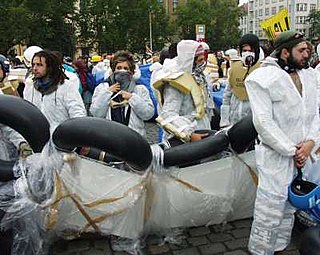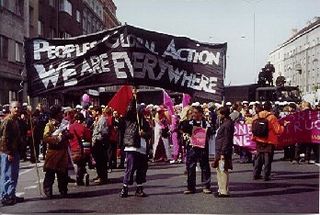
The Independent Media Center, better known as Indymedia, is an open publishing network of activist journalist collectives that report on political and social issues. Following beginnings during the 1999 Carnival Against Capital and 1999 Seattle WTO protests, Indymedia became closely associated with the global justice movement. The Indymedia network extended internationally in the early 2000s with volunteer-run centers that shared software and a common format with a newswire and columns. Police raided several centers and seized computer equipment. The centers declined in the 2010s with the waning of the global justice movement.
The WOMBLES were a loosely aligned anarchist and anti-capitalist group based in London. They gained prominence in the early 2000s for wearing white overalls with padding and helmets at May Day protests, mimicking the Italian group Tute Bianche.

Reclaim the Streets also known as RTS, are a collective with a shared ideal of community ownership of public spaces. Participants characterise the collective as a resistance movement opposed to the dominance of corporate forces in globalisation, and to the car as the dominant mode of transport.

A black bloc is a tactic used by protesters who wear black clothing, ski masks, scarves, sunglasses, motorcycle helmets with padding or other face-concealing and face-protecting items. The clothing is used to conceal wearers' identities from both the police and politically different organizations by making it difficult to distinguish between participants. It is also used to protect their faces and eyes from pepper spray, which is used by police during protests or civil unrest. The tactic also allows the group to appear as one large unified mass. Black bloc participants are often associated with anarchism, anarcho-communism, communism, libertarian socialism and the anti-globalization movement. A variant of this type of protest is the Padded bloc, where following the Tute Bianche movement protesters wear padded clothing to protect against the police.

Tute Bianche, Italian for "White Overalls", was a militant Italian social movement, active from 1994 to 2001. Activists were notable for covering. their bodies with white padding so as to resist the blows of police, pushing through police lines, and marching together in large blocks for mutual protection during demonstrations.

The Youth International Party (YIP), whose members were commonly called Yippies, was an American youth-oriented radical and countercultural revolutionary offshoot of the free speech and anti-war movements of the late 1960s. It was founded on December 31, 1967. They employed theatrical gestures to mock the social status quo, such as advancing a pig as a candidate for President of the United States in 1968. They have been described as a highly theatrical, anti-authoritarian, and anarchist youth movement of "symbolic politics".

A protest is a public expression of objection, disapproval, or dissent towards an idea or action, typically a political one. Protests can be thought of as acts of cooperation in which numerous people cooperate by attending, and share the potential costs and risks of doing so. Protests can take many different forms, from individual statements to mass political demonstrations. Protesters may organize a protest as a way of publicly making their opinions heard in an attempt to influence public opinion or government policy, or they may undertake direct action in an attempt to enact desired changes themselves. When protests are part of a systematic and peaceful nonviolent campaign to achieve a particular objective, and involve the use of pressure as well as persuasion, they go beyond mere protest and may be better described as civil resistance or nonviolent resistance.

Peoples' Global Action (PGA) was the name of a worldwide co-ordination of radical social movements, grassroots campaigns and direct actions in resistance to capitalism and for social and environmental justice. PGA was part of the anti-globalization movement.

The 27th G8 summit was held in Genoa, Italy, on 19–22 July 2001 and is remembered as a highpoint of the worldwide anti-globalization movement as well as for human rights violations against demonstrators.

Mikhail Mikhailovich Bakhtin was a Russian philosopher, literary critic and scholar who worked on literary theory, ethics, and the philosophy of language. His writings, on a variety of subjects, inspired scholars working in a number of different traditions and in disciplines as diverse as literary criticism, history, philosophy, sociology, anthropology and psychology. Although Bakhtin was active in the debates on aesthetics and literature that took place in the Soviet Union in the 1920s, his distinctive position did not become well known until he was rediscovered by Russian scholars in the 1960s.

Rhythms of Resistance, sometimes abbreviated to RoR, is a network of percussion bands that play at demonstrations and direct actions that fall within the broad definition of 'anti-capitalist'. Since RoR London was formed in 2000, similar groups have arisen around the world; while not all such bands use the Rhythms of Resistance name, they generally share the same ideology, described on the RoR website:
- We are a transnational anti-hierarchical anticapitalist, antisexist and antiracist network fighting for social and ecological justice.
- We are activists using tactical frivolity as a form of political action to confront any system of domination.
- We also directly support everybody experiencing or struggling against exploitation, discrimination and oppression, without compromising our principles.
- Our tactics include drumming and dancing inspired by samba and carnival.
- We reject any false opposition between militancy and creative forms of resistance.
- Even if we are different bands operating in a decentralized fashion, we aim to maximise participation in our collective process.
- We are an open network to any people who share our principles.
- Come with us! We have everything to play for!

Dissent! was the name adopted by an international network of local groups, which came together to organise opposition to the G8 summit held at Gleneagles Hotel, Perthshire, Scotland, in July 2005. Most groups shared an anti-capitalist orientation and anti-authoritarian organizing methods and the network declares itself to be open to anyone prepared to work within the Hallmarks of Peoples' Global Action, an international co-ordination of radical social movements and grassroots campaigns. Dissent acted as a networking tool and created infrastructure which was used by groups with methods of protest ranging from anti-border city tours and street parties to road blockades, graffiti and confrontations with the police.

The Clandestine Insurgent Rebel Clown Army was an anti-authoritarian left-wing activist group primarily active from 2003-2005 in the United Kingdom. The Clown Army used clowning and non-violent tactics to act against corporate globalisation, war, capitalism, and heavy policing of protests, among other issues.
Pigasus, also known as Pigasus the Immortal and Pigasus J. Pig, was a 145-pound (66 kg) domestic pig that was nominated for President of the United States as a theatrical gesture by the Youth International Party on August 23, 1968, just before the opening of the Democratic National Convention in Chicago, Illinois. The youth-oriented party was an anti-establishment and countercultural revolutionary group whose views were inspired by the free speech and anti-war movements of the 1960s, mainly the opposition to United States involvement in the Vietnam War.
The Carnival Against Capital took place on Friday 18 June 1999. It was an international day of protest timed to coincide with the 25th G8 summit in Cologne, Germany. The carnival was inspired by the 1980s Stop the City protests, Peoples' Global Action and the Global Street Party, which happened at the same time as the 1998 24th G8 Summit in Birmingham. The rallying slogan was Our Resistance is as Transnational as Capital.
1984 Network Liberty Alliance is a loose group of software programmers, artists, social activists and militants, interested in computers and networks and considering them tools to empower and link the various actors of the social movement around the world. They are part of the hacktivism movement.
Guerrilla theatre, generally rendered "guerrilla theater" in the US, is a form of guerrilla communication originated in 1965 by the San Francisco Mime Troupe, who, in spirit of the Che Guevara writings from which the term guerrilla is taken, engaged in performances in public places committed to "revolutionary sociopolitical change." The group performances, aimed against the Vietnam War and capitalism, sometimes contained nudity, profanity and taboo subjects that were shocking to some members of the audiences of the time.

The anti-globalization movement, or the counter-globalization movement, is a social movement which is critical of economic globalization. The movement is also commonly referred to as the global justice movement, alter-globalization movement, anti-globalist movement, anti-corporate globalization movement, or movement against neoliberal globalization. There are many definitions of anti-globalization.

Redneck Revolt is an American political group that organizes predominantly among working-class people. The group supports gun rights and members often openly carry firearms. Its political positions are anti-capitalist, anti-racist and anti-fascist. Founded in Kansas in 2009, members were present at several protests against Donald Trump and against the far-right in 2017.
















